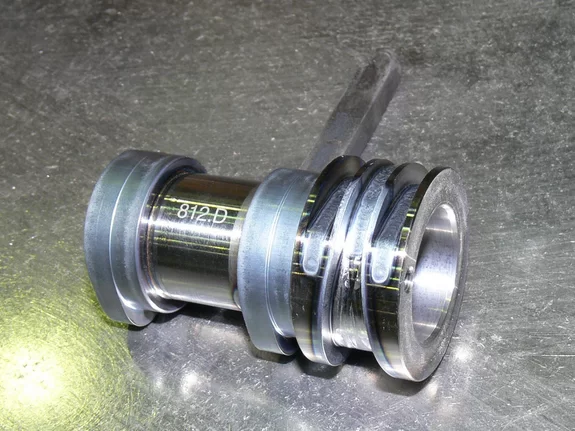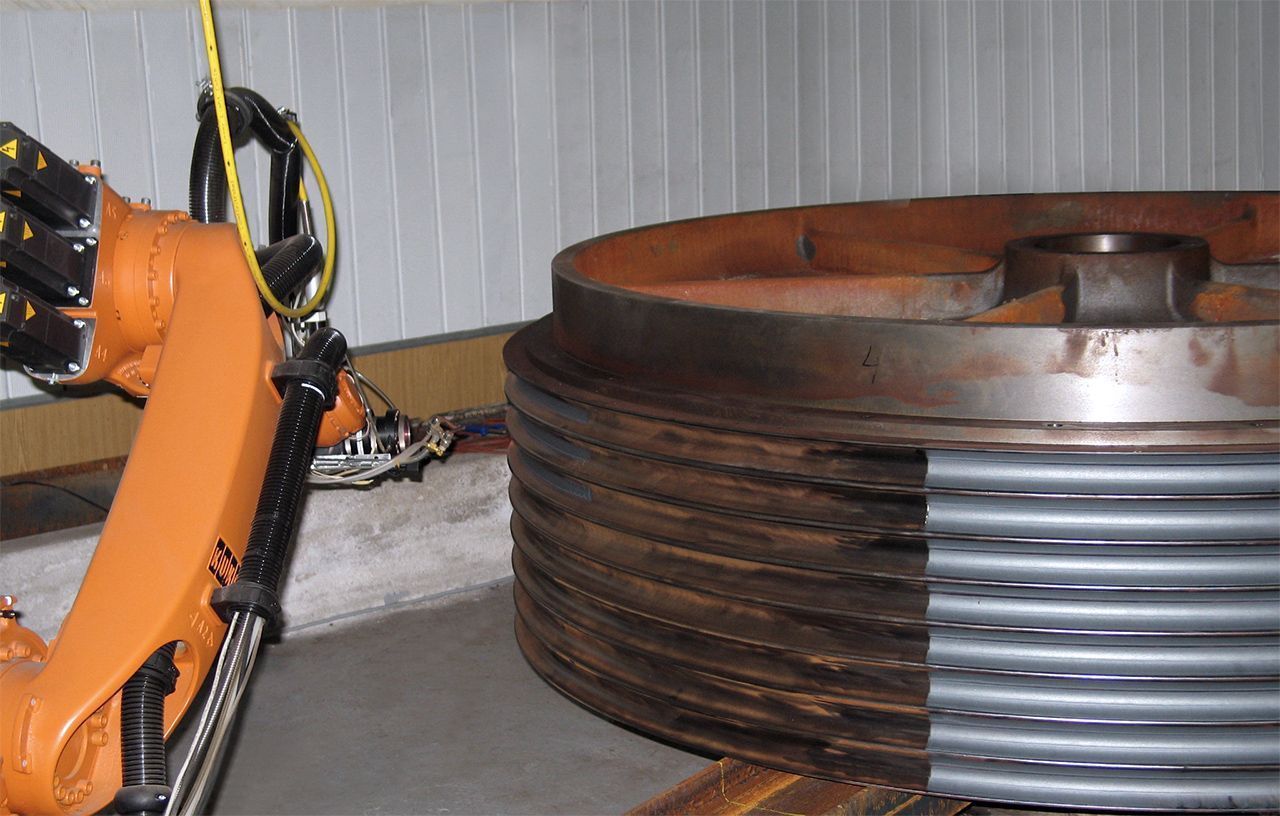Laser Hardening
Homogeneous heat treatment, suitability for all component geometries, and high efficiency are the characteristics of laser hardening using high power diode lasers.
To the examplesHomogeneous heat treatment, suitability for all component geometries, and high efficiency are the characteristics of laser hardening using high power diode lasers.
To the examplesThe goal of all metal hardening processes is to ensure a structural transformation of steel and cast-iron materials to give them greater strength. First, the original ferritic-perlitic material structure is austenitized by heating, and then transformed into hard martensite by quenching. Here, hardening with high-power diode lasers has the decisive advantage of enabling heat to be provided in specific stressed areas exclusively. For complex components, this enables parts to be hardened, while, in other zones, the ductility of the initial structure can be maintained. This localized treatment is not possible in many cases with induction hardening, which thus has disadvantages compared to laser hardening. As the workpiece is only heated near the surface with a low hardening depth in laser brazing, the heat is therefore discharged very efficiently over the neighboring material. Thus, there is no need for an additional quenching media in most cases, which keeps costs low. As the warpage is rather minimal compared to other hardening techniques, there is generally no need for additional methods to correct the material deformations.
The processes of laser surface hardening can generally be deployed for all the materials for which traditional hardening methods can be used, due to their adequate carbon content. With laser hardening, only the highly stressed areas of the components are locally hardened, e.g. steels and cast iron in tool manufacturing. The thermal treatment of wear-stressed or cyclically stressed component areas – e.g. in contract production – can be realized highly effectively and flexibly in combination with a Laserline OTZ Zoom optic.
Diode lasers are especially suitable for hardening the surface of steelwork components. The laser beam heats up areas close to the surface of a workpiece to between 900°C and 1500°C, causing the heat-induced austenitization of the originally ferritic-perlitic steel structure. When the beam moves on, the material on the processed part cools down quickly (self-quenching), creating hard martensite. For many reasons, this process can clearly be realized more efficiently with lasers than with induction coils or gas flames. Firstly, the material physically heats up more quickly than with other methods. Secondly, the zones of relevance for hardening can be treated more selectively, meaning that the local heat input only heats up certain parts of the workpiece. And thirdly, the heat input can be dosed in an exact manner by means of special beam shaping optics with integrated pyrometers or thermal cameras, not least with particular focus on different local heat conductions for the same component. Thanks to these characteristics, the diode laser is extremely well-suited to treating geometric complex structures that require hardening in some zones but have to keep their ductility in others. Furthermore, these process advantages allow for cost savings. That is, because of the low deformation and self-quenching of the material, usually no (or only little) action is required in terms of distortion compensation and cooling. Finally, this has a positive impact in terms of the time and material required.
Hardening with diode lasers makes it possible to achieve the maximum hardness for machine components, tools, component parts, and commodities, specific to the material in question. Temperature regulation during the metal hardening process ensures that the optimum process results are reached for each material and application. However, heat treatment can also be used to locally reduce the firmness of high-strength materials to provide better deformability in those local areas.
Compared to other processes, a diode laser offers many advantages:


This treatment is especially ideal for wear-stressed or cyclically stressed components such as camshafts. In every gasoline and diesel engine, steel rubs against steel. As a result, the contact zones need to be hardened, otherwise the parts are unlikely to have much longevity. The inductive method is of little help when it comes to these complex structures. The construction of modern camshafts (with different shaped cams and shifting gates for the cylinder deactivation or change in the engine control) requires precise surface hardening which is only possible with diode lasers. Diode lasers have even been long-established in the manufacturing of large sheet metal tools, with the oldest hardening systems in this regard already having been in use for 10 to 15 years. As the prices of laser beam sources have been decreasing for years now, new applications are continuously being explored alongside these typical fields of use.
Laser hardening is related to surface hardening processes. Usually, the ultra-stressed areas of components made from steel or cast iron are only hardened on a local level, e.g. in tool manufacturing for vehicle body construction.
The beam structure is only heated and changed within the near-surface areas of a workpiece, e.g. in the surface layer. With quenched and tempered steels, this area of hardening depth can be up to 1.5 mm thick. As the diode laser beam can be directed selectively and flexibly onto the workpiece from just about any direction and the temperature of the workpiece can be controlled precisely, it is possible to carry out surface hardening of geometrically highly complex components. From gear wheels, sprocket wheels, cam and worm shafts to gripping and cutting tools in rope drums, almost every surface geometry can be successfully hardened with Laserline’s diode lasers.
Camshafts are used in combustion engines. Their complex geometry, needed for switching control times or partial cylinder deactivation as well as their extreme material stress usage scenario, requires accurate and selective hardening. The beam structure of the component edge layer is thereby hardened locally only. In the subjacent material, the ductile structure needs to remain so that the permanently stressed shaft can withstand both highly static and dynamic loads.


Contract manufacturing and metal processing companies rely on hardening process orders, as it is not worth them buying their own hardening equipment for various reasons. These companies operate in different areas, meaning that they need to be able to handle various requirement demands. Laserline’s diode lasers are an excellent tool. As the beam can be guided flexibly and at a precise temperature, they can treat almost every workpiece successfully. In terms of purchasing them, they are the most economically advantageous of all the available beam sources due to their comparatively low costs.
In addition, their high energy efficiency, long service life and low maintenance requirements also make them outstandingly economical to operate.
MATEX PM, a company from Pilsen in the Czech Republic, offers job-shop solutions for various metal applications using diode lasers. Together with Laserline, MATEX PM has, for example, crafted a method that allows laser hardening to protect a rope drum made from cast iron with a diameter of two meters and a weight of 2.5 tons from suffering excessive wear when in use.
Which laser systems are particularly suitable for hardening? Here you will find a selection.